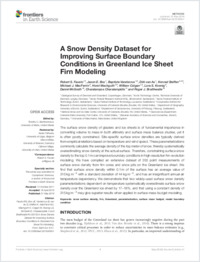A snow density dataset for improving surface boundary conditions in greenland ice sheet firn modeling
- Fausto, Robert S. Geological Survey of Denmark and Greenland, Copenhagen, Denmark
- Box, Jason E. Geological Survey of Denmark and Greenland, Copenhagen, Denmark
- Vandecrux, Baptiste Geological Survey of Denmark and Greenland, Copenhagen, Denmark - Arctic Technology Centre, Technical University of Denmark, Lyngby, Denmark
- As, Dirk van Geological Survey of Denmark and Greenland, Copenhagen, Denmark
- Steffen, Konrad Swiss Federal Research Institute WSL, Birmensdorf, Switzerland - Swiss Federal Institute of Technology, Zurich, Switzerland - Swiss Federal Institute of Technology, Lausanne, Switzerland
- MacFerrin, Michael J. Cooperative Institute for Research in Environmental Sciences, University of Colorado Boulder, Boulder, USA
- Machguth, Horst Department of Geography, University of Zurich, Zurich, Switzerland - Department of Geosciences, University of Fribourg, Fribourg, Switzerland
- Colgan, William Geological Survey of Denmark and Greenland, Copenhagen, Denmark - Cooperative Institute for Research in Environmental Sciences, University of Colorado Boulder, Boulder, USA
- Koenig, Lora S. National Snow and Ice Data Center, University of Colorado, Boulder, USA
- McGrath, Daniel Geosciences Department, Colorado State University, Fort Collins, USA
- Charalampidis, Charalampos Bavarian Academy of Sciences and Humanities, Munich, Germany
- Braithwaite, Roger J. University of Manchester, Manchester, UK
-
2018
Published in:
- Frontiers in Earth Science. - 2018, vol. 6, p. 51
English
The surface snow density of glaciers and ice sheets is of fundamental importance in converting volume to mass in both altimetry and surface mass balance studies, yet it is often poorly constrained. Site-specific surface snow densities are typically derived from empirical relations based on temperature and wind speed. These parameterizations commonly calculate the average density of the top meter of snow, thereby systematically overestimating snow density at the actual surface. Therefore, constraining surface snow density to the top 0.1 m can improve boundary conditions in high-resolution firn-evolution modeling. We have compiled an extensive dataset of 200 point measurements of surface snow density from firn cores and snow pits on the Greenland ice sheet. We find that surface snow density within 0.1 m of the surface has an average value of 315 kg m−3 with a standard deviation of 44 kg m−3, and has an insignificant annual air temperature dependency. We demonstrate that two widely- used surface snow density parameterizations dependent on temperature systematically overestimate surface snow density over the Greenland ice sheet by 17–19%, and that using a constant density of 315 kg m−3 may give superior results when applied in surface mass budget modeling.
- Faculty
- Faculté des sciences et de médecine
- Department
- Département de Géosciences
- Language
-
- English
- Classification
- Hydrology
- License
-
License undefined
- Identifiers
-
- RERO DOC 323368
- DOI 10.3389/feart.2018.00051
- Persistent URL
- https://folia.unifr.ch/unifr/documents/307422
Other files
Statistics
Document views: 116
File downloads:
- pdf: 191
- Supplementary material: 74

